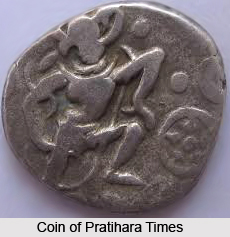 After the death of Vatsaraja, Nagabhata II succeeded him as a king. He ruled from 805 to 833 A.D. Sundari Devi was the name of his mother. He was a very brave and courageous king. He tried to achieve the past glory of his dynasty and not only consolidated the existing empire but also increased the frontiers of his empire. It can be learnt from the copper plate inscriptions that near about 807 A.D. he fought against the Govinda III. Govinda III was the `King of the Rashtrakut dynasty` which was old enemy of his dynasty. It is stated that Nagabhata was defeated in this war. After defeating Nagabhata, Govinda III entered into a treaty with Dharmapala and thus controlled and occupied the vast area of central India. But soon he had to return to his capital on account of internal quarrels.
After the death of Vatsaraja, Nagabhata II succeeded him as a king. He ruled from 805 to 833 A.D. Sundari Devi was the name of his mother. He was a very brave and courageous king. He tried to achieve the past glory of his dynasty and not only consolidated the existing empire but also increased the frontiers of his empire. It can be learnt from the copper plate inscriptions that near about 807 A.D. he fought against the Govinda III. Govinda III was the `King of the Rashtrakut dynasty` which was old enemy of his dynasty. It is stated that Nagabhata was defeated in this war. After defeating Nagabhata, Govinda III entered into a treaty with Dharmapala and thus controlled and occupied the vast area of central India. But soon he had to return to his capital on account of internal quarrels.
Conquest of Kannauj
Nagabhata availed this opportunity and after mobilizing his forces attacked Kannauj. Nagabhata gave a crushing defeat to king Chakrayudha of Kannauj and made Kannauj his capital. Since this time the Pratiharas ruled over Kannauj for a long time.
Conquest over Dharampala:
King Chakrayudha of Kannauj was under the protection of Dharampala. On hearing the defeat of Chakrayudha he fought against Nagabhata II, but was defeated by him. Gwalior inscription may be cited as an evidence of the victory of Nagabhata.
Jodhpur inscription also indicates that Banka`s father Wavaka had fought against the Gauda`s in Mudagagiri. Kavaka was the samanta of Nagabhata II and was ruling over Rajputana. Baroda and Chatusu inscriptions also enlighten about the conquest of Nagabhata.
Other conquests by Nagabhata
Nagabhata had also conquered Andhra, Sindh, Vidarbha and Kalinga. Gwalior prasasti of Mihirabhoja states that is to say the kings of Andhra, Sindh, Vidharba and Kalinga came to his shelter in the same manner as the moths fell to the fire.
The Gwalior inscription also gives us information about the other conquests of Nagabhata. According to the said prasasti, Nagabhata had also forcibly snatched the territories of Avanti i.e. Northern Kathiawar. Malava or central India, Kirat i.e. some kingdom in the Himachal Pradesh. Turushka i.e. muslim kingdom of western India, Vatsa or Kausambi, Matasaya, etc.
Conquest over Muslims: On the basis of the aforementioned evidences, it is obvious that Nagabhata had also defeated the Muslims. There is clear reference of the defeat of the Turushkas in Gwalior inscription. Scholars are of the opinion that it was Sultan Beg Varis of Bashar who had attacked the western portion of the empire of the Pratiharas. Nagabhata, with the help of his samanta, Govindaraj, had successfully driven away the Muslims.
Conquest over Chauhana
From the various inscriptions it can be learnt that Nagabhata had also conquered the Chauhanas. It is stated in the book named `Prithvi Raj Vijaya` that Chauhana guvaka had married his sister with the king of Kannauj. Guvaka I was the contemporary of Nagabhata and hence this marriage must have been with Nagabhata II.
On account of the aforementioned conquest, Nagabhata had adopted many titles. The most prominent of his titles can be mentioned as `Pram-bhattarak`, `Maharajadhiraja`, `Parmeshwara`, etc. Regarding the death of Nagabhata II, almost all the scholars are unanimous that he died in 833 A.D.



















